warning SKODA SUPERB 2009 2.G / (B6/3T) Owner's Manual
[x] Cancel search | Manufacturer: SKODA, Model Year: 2009, Model line: SUPERB, Model: SKODA SUPERB 2009 2.G / (B6/3T)Pages: 294, PDF Size: 21.33 MB
Page 179 of 294
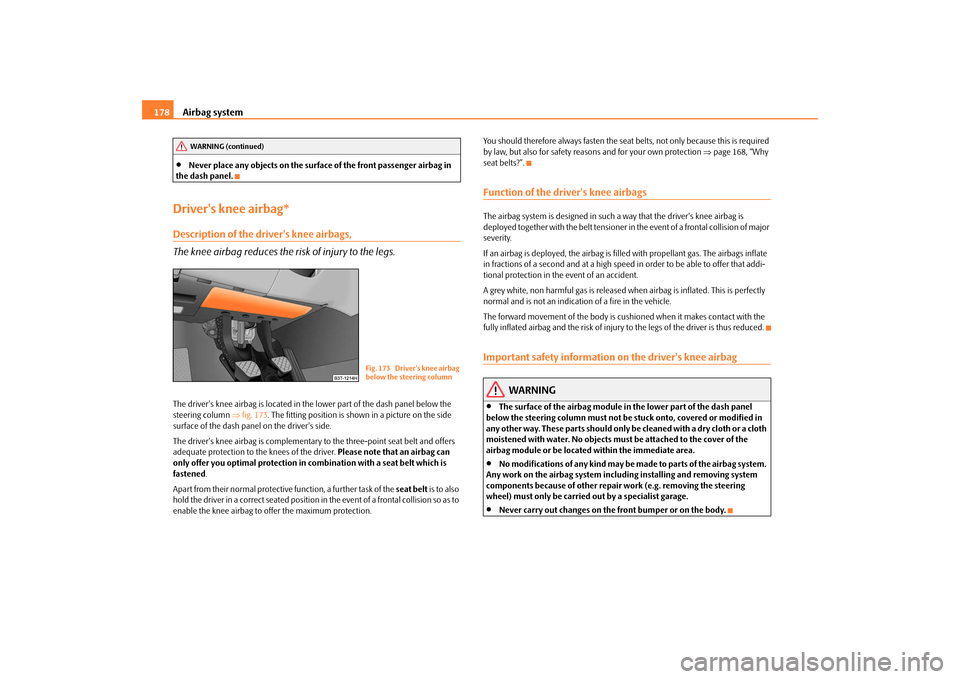
Airbag system
178
•
Never place any objects on the surfac
e of the front passenger airbag in
the dash panel.Driver's knee airbag*Description of the driver's knee airbags, The knee airbag reduces the ri
sk of injury to the legs.
The driver's knee airbag is located in th
e lower part of the dash panel below the
steering column
⇒fig. 173
. The fitting position is show
n in a picture on the side
surface of the dash panel on the driver's side. The driver's knee airbag is complementary
to the three-point seat belt and offers
adequate protection to the knees of the driver.
Please note that an airbag can
only offer you optimal protection in combination with a seat belt which is fastened
.
Apart from their normal protective
function, a further task of the
seat belt
is to also
hold the driver in a correct seated position in
the event of a frontal collision so as to
enable the knee airbag to offer the maximum protection.
You should therefore always fasten the seat
belts, not only because this is required
by law, but also for safety reasons and for your own protection
⇒page 168, “Why
seat belts?”.Function of the driver's knee airbagsThe airbag system is designed in such a way that the driver's knee airbag is deployed together with the belt tensioner in the event of a frontal collision of major severity. If an airbag is deployed, th
e airbag is filled with propellant gas. The airbags inflate
in fractions of a second and at a high spee
d in order to be able to offer that addi-
tional protection in the event of an accident. A grey white, non harmful gas is released when airbag is inflated. This is perfectly normal and is not an indicati
on of a fire in the vehicle.
The forward movement of the body is cush
ioned when it makes contact with the
fully inflated airbag and the risk of injury
to the legs of the driver is thus reduced.
Important safety information on the driver's knee airbag
WARNING
•
The surface of the airbag module in
the lower part of the dash panel
below the steering column must not be stuck onto, covered or modified in any other way. These parts should only be cleaned with a dry cloth or a cloth moistened with water. No objects must be attached to the cover of the airbag module or be located within the immediate area.•
No modifications of any kind may be made to parts of the airbag system.
Any work on the airbag system including installing and removing system components because of other repair work (e.g. removing the steering wheel) must only be carried out by a specialist garage.•
Never carry out changes on the front bumper or on the body.
WARNING (continued)
Fig. 173 Driver's knee airbag below the steering column
s2dk.1.book Page 178 Wednesday, April 8, 2009 12:23 PM
Page 181 of 294

Airbag system
180
Important safety information on the side airbag Correct use of the airbag system considerably reduces the risk of injury!
WARNING
•
It is essential to always switch off
⇒page 182, “Deactivating an airbag”
the front passenger airbag when attaching a child safety seat on the front passenger seat where the child is seated
with its back facing in direction of
travel (in some countries also when the ch
ild is facing the direction of travel).
If this is not done, there is a risk of the child suffering severe or even fatal injuries if the front passenger airbag
is deployed. In certain countries
national legal provisions also requir
e that the side or head passenger
airbags be deactivated. When transporting a child on the front passenger seat, please comply with the appropri
ate national regula
tions regarding the
use of child safety seats.•
Your head should never be positioned
in the deployment area of the side
airbag. You might suffer severe injuries in the event of an accident. This applies in particular to children who are transported without using a suit- able child safety seat
⇒page 187, “Child safety and side airbag*”.
•
If children adopt an incorrect seated position when travelling, they may
be exposed to an increased risk of injury
in the event of an accident. This can
result in serious injuries
⇒page 185, “What you should know about trans-
porting children!”.•
There must not be any further persons,
animals as well as objects posi-
tioned between the occupants and the de
ployment area of the airbag. There
must also be no accessories such as cup holders, attached to the doors to enable the side airbags to activate properly.•
The airbag control unit operates to
gether with the pressure sensors,
which are attached in the front doors. For this reason no adjustments must be carried out at the doors as well as at the door panels (for example addi- tional installation of loudspeakers).
Resulting damages can have a negative
affect on the operation of the airbag system. All work on the front doors and their panels must only be carried out by a specialist garage.
•
In the event of a side collision, the side airbags will not function properly,
if the sensors cannot measure the increasing air pressure inside the doors, because the air can escape through lar
ge, non-sealed openings in the door
panel.
− Never drive with removed inner door panels. − Never drive, if parts of the inner
door panel have been removed and
the remaining openings have not been properly sealed. − Never drive, if the loudspeakers in the doors have been removed, only if the loudspeaker openings have been properly sealed. − Always make sure that the openings
are covered or filled, if additional
loudspeakers or other equipment part
s are installed in the inner door
panels. − Always work with an authorised Škoda dealer or have it carried out by a competent specia
list workshop.
•
Only hang light items of clothing on the clothes hooks to the vehicle.
Never leave any heavy or sh
arp-edged objects in the pockets of the items of
clothing.•
Ensure that there are no excessive fo
rces, such as violent knocks, kicks
etc., impact on the backrests of th
e seats otherwise the system may be
damaged. The side airbags would not be deployed in such a case!•
Any seat or protective covers which you fit to the driver or front
passenger seats must only be of the type expressly authorised by Škoda Auto. In view of the fact that the airbag inflates out of the backrest of the seat, use of non-approved seat or protective covers would considerably impair the protective function of the side airbag.•
Any damage to the original seat covers in the area of the side airbag
module must be repaired without
delay by your specialist garage.
•
The airbag modules in the front se
ats must not display any damage,
cracks or deep scratches. It is not permissible to use force in order to open the modules.
WARNING (continued)
s2dk.1.book Page 180 Wednesday, April 8, 2009 12:23 PM
Page 182 of 294
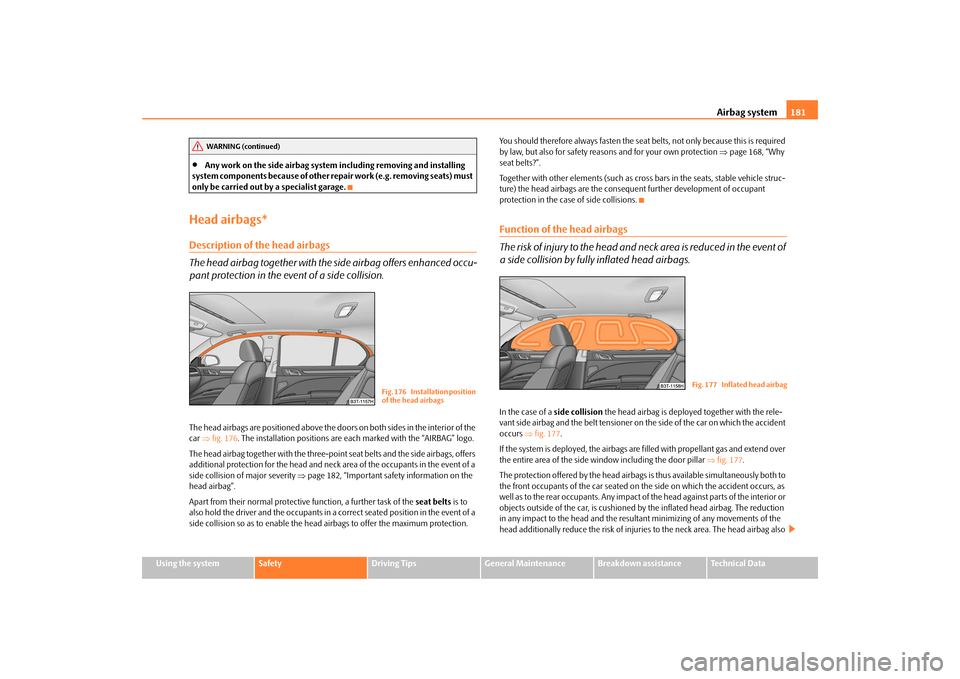
Airbag system
181
Using the system
Safety
Driving Tips
General Maintenance
Breakdown assistance
Technical Data
•
Any work on the side airbag system
including removing and installing
system components because of other repair work (e.g. removing seats) must only be carried out by a specialist garage.Head airbags*Description of the head airbags The head airbag together with the
side airbag offers enhanced occu-
pant protection in the event of a side collision.The head airbags are positioned above the d
oors on both sides in the interior of the
car
⇒fig. 176
. The installation positions are each
marked with the “AIRBAG” logo.
The head airbag together with the three-poin
t seat belts and the side airbags, offers
additional protection for the head and neck
area of the occupants in the event of a
side collision of major severity
⇒page 182, “Important safety information on the
head airbag”. Apart from their normal protective function, a further task of the
seat belts
is to
also hold the driver and the occupants in a
correct seated position in the event of a
side collision so as to enable the head
airbags to offer the maximum protection.
You should therefore always fasten the seat
belts, not only because this is required
by law, but also for safety reas
ons and for your own protection
⇒page 168, “Why
seat belts?”. Together with other elements (such as cros
s bars in the seats, stable vehicle struc-
ture) the head airbags are the conseque
nt further development of occupant
protection in the case of side collisions.Function of the head airbags The risk of injury to the head and ne
ck area is reduced in the event of
a side collision by fully inflated head airbags.In the case of a
side collision
the head airbag is deploy
ed together with the rele-
vant side airbag and the belt tensioner on
the side of the car on which the accident
occurs
⇒fig. 177
.
If the system is deployed, the airbags are filled with propellant gas and extend over the entire area of the side window including the door pillar
⇒fig. 177
.
The protection offered by the head airbags
is thus available simu
ltaneously both to
the front occupants of the car seated on th
e side on which the accident occurs, as
well as to the rear occupants. Any impact of
the head against parts of the interior or
objects outside of the car, is cushioned by
the inflated head airbag. The reduction
in any impact to the head and the result
ant minimizing of any movements of the
head additionally reduce the
risk of injuries to the neck
area. The head airbag also
WARNING (continued)
Fig. 176 Installation position of the head airbags
Fig. 177 Inflated head airbag
s2dk.1.book Page 181 Wednesday, April 8, 2009 12:23 PM
Page 183 of 294
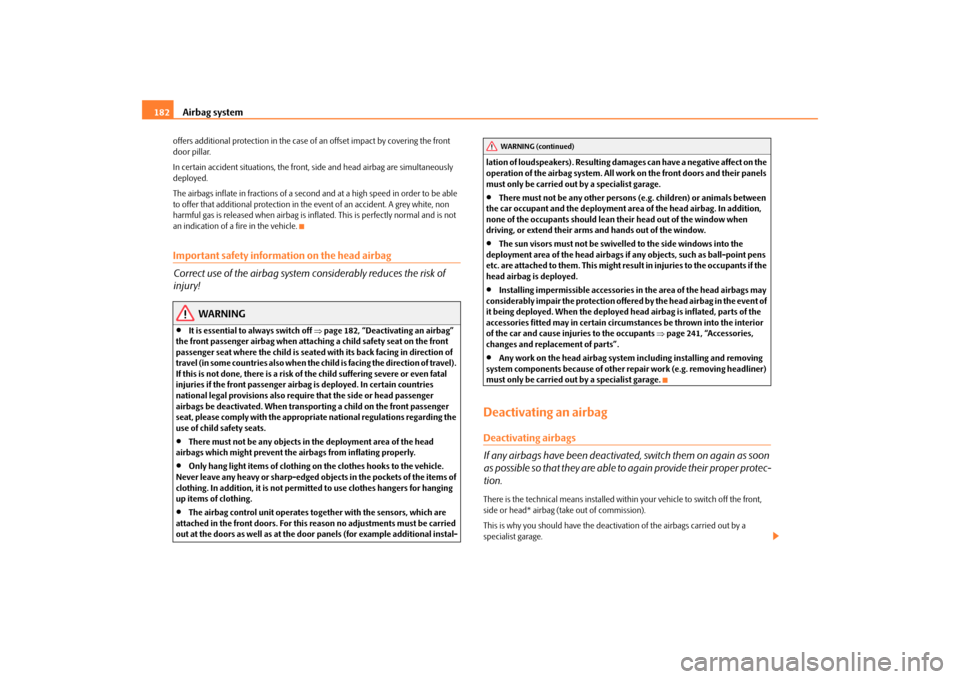
Airbag system
182
offers additional protection in the case of
an offset impact by covering the front
door pillar. In certain accident situations, the front,
side and head airbag are simultaneously
deployed. The airbags inflate in fractions of a second
and at a high speed in order to be able
to offer that additional protection in th
e event of an accident. A grey white, non
harmful gas is released when airbag is inflated. This is perfectly normal and is not an indication of a fire in the vehicle.Important safety information on the head airbag Correct use of the airbag system considerably reduces the risk of injury!
WARNING
•
It is essential to always switch off
⇒page 182, “Deactivating an airbag”
the front passenger airbag when attaching a child safety seat on the front passenger seat where the child is seated
with its back facing in direction of
travel (in some countries also when the ch
ild is facing the direction of travel).
If this is not done, there is a risk of the child suffering severe or even fatal injuries if the front passenger airbag
is deployed. In certain countries
national legal provisions also requir
e that the side or head passenger
airbags be deactivated. When transporting a child on the front passenger seat, please comply with the appropri
ate national regula
tions regarding the
use of child safety seats.•
There must not be any objects in the deployment area of the head
airbags which might prevent the airbags from inflating properly.•
Only hang light items of clothing on the clothes hooks to the vehicle.
Never leave any heavy or sharp-edged ob
jects in the pockets of the items of
clothing. In addition, it is not permitted to use clothes hangers for hanging up items of clothing.•
The airbag control unit operates to
gether with the sensors, which are
attached in the front doors. For this reason no adjustments must be carried out at the doors as well as at the door panels (for example additional instal-
lation of loudspeakers). Resulting dama
ges can have a negative affect on the
operation of the airbag system. All work on the front doors and their panels must only be carried out by a specialist garage.•
There must not be any other persons
(e.g. children) or animals between
the car occupant and the deployment area of the head airbag. In addition, none of the occupants should lean their head out of the window when driving, or extend their arms and hands out of the window.•
The sun visors must not be swivelled to the side windows into the
deployment area of the head airbags if any objects, such as ball-point pens etc. are attached to them. This might resu
lt in injuries to
the occupants if the
head airbag is deployed.•
Installing impermissible accessories in the area of the head airbags may
considerably impair the protection offere
d by the head airbag in the event of
it being deployed. When the deployed head airbag is inflated, parts of the accessories fitted may in certain circum
stances be thrown into the interior
of the car and cause injuries to the occupants
⇒page 241, “Accessories,
changes and replacement of parts”.•
Any work on the head airbag system including installing and removing
system components because of other repair work (e.g. removing headliner) must only be carried out by a specialist garage.Deactivating an airbagDeactivating airbags If any airbags have been deactivated, switch them on again as soon as possible so that they are able to
again provide their proper protec-
tion.There is the technical means installed within
your vehicle to switch off the front,
side or head* airbag (take out of commission). This is why you should have the deacti
vation of the airbags carried out by a
specialist garage.
WARNING (continued)
s2dk.1.book Page 182 Wednesday, April 8, 2009 12:23 PM
Page 184 of 294
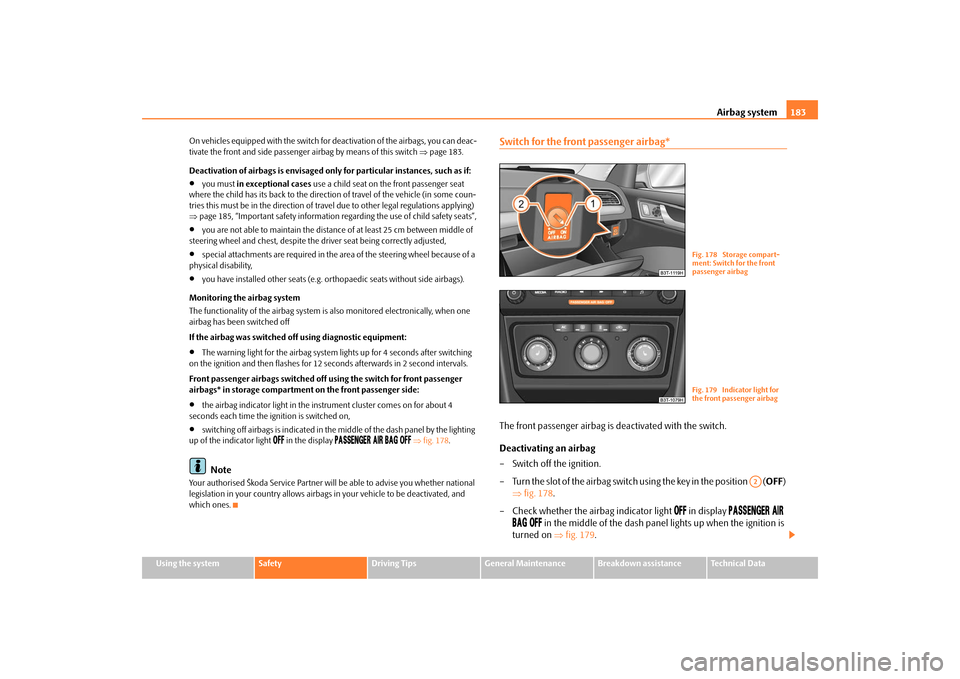
Airbag system
183
Using the system
Safety
Driving Tips
General Maintenance
Breakdown assistance
Technical Data
On vehicles equipped with the switch for deactivation of the airbags, you can deac- tivate the front and side passenger airbag by means of this switch
⇒page 183.
Deactivation of airbags is envisaged only
for particular inst
ances, such as if:
•
you must
in exceptional cases
use a child seat on the front passenger seat
where the child has its back to the directio
n of travel of the ve
hicle (in some coun-
tries this must be in the direction of travel due to other legal regulations applying) ⇒ page 185, “Important safety information regarding the use of child safety seats”,•
you are not able to maintain the distance
of at least 25 cm between middle of
steering wheel and chest, despite the driver seat being correctly adjusted,•
special attachments are required in the area of the steering wheel because of a
physical disability,•
you have installed other seats (e.g. orthopaedic seats without side airbags).
Monitoring the airbag system The functionality of the airbag system is also monitored electronically, when one airbag has been switched off If the airbag was switched of
f using diagnostic equipment:
•
The warning light for the airbag system
lights up for 4 seconds after switching
on the ignition and then flashes for 12 seconds afterwards in 2 second intervals. Front passenger airbags switched off
using the switch for front passenger
airbags* in storage compartmen
t on the front passenger side:
•
the airbag indicator light in the inst
rument cluster comes on for about 4
seconds each time the ig
nition is switched on,
•
switching off airbags is indicated in the middle of the dash panel by the lighting
up of the indicator light
in the display
⇒fig. 178
.
Note
Your authorised Škoda Service Partner will
be able to advise
you whether national
legislation in your country allows airbags
in your vehicle to
be deactivated, and
which ones.
Switch for the front passenger airbag*The front passenger airbag is deactivated with the switch. Deactivating an airbag – Switch off the ignition. – Turn the slot of the airbag switch using the key in the position (
OFF
)
⇒
fig. 178
.
– Check whether the airbag indicator light
in display
in the middle of the dash panel
lights up when the ignition is
turned on
⇒
fig. 179
.
Fig. 178 Storage compart- ment: Switch for the front passenger airbagFig. 179 Indicator light for the front passenger airbag
A2
s2dk.1.book Page 183 Wednesday, April 8, 2009 12:23 PM
Page 185 of 294
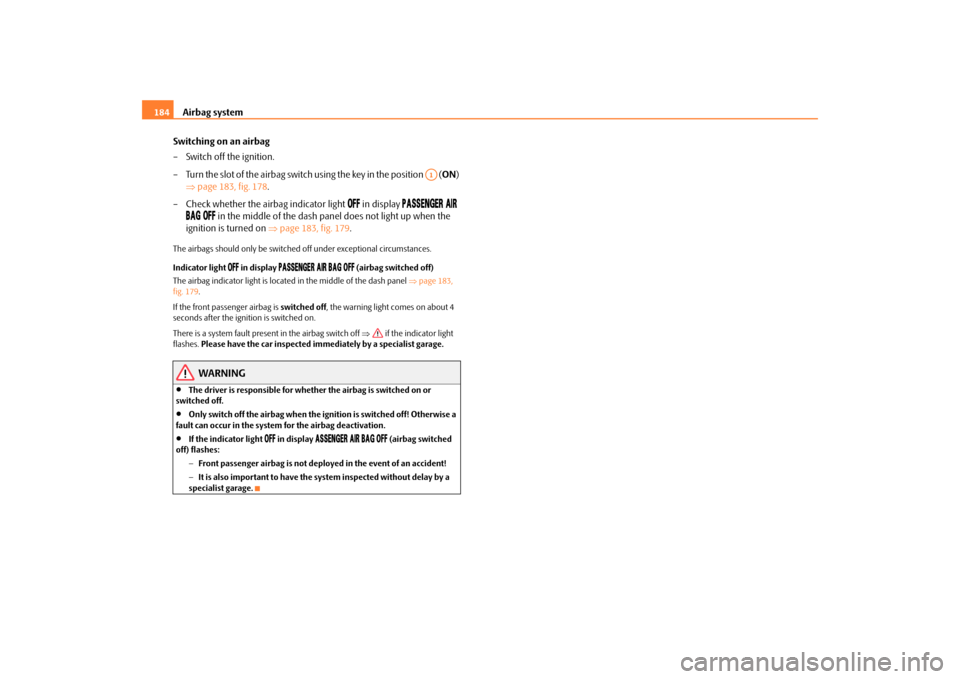
Airbag system
184
Switching on an airbag – Switch off the ignition. – Turn the slot of the airbag switch using the key in the position (
ON
)
⇒
page 183, fig. 178
.
– Check whether the airbag indicator light
in display
in the middle of the dash pa
nel does not light up when the
ignition is turned on
⇒
page 183, fig. 179
.
The airbags should only be switched
off under exceptional circumstances.
Indicator light
in display
(airbag switched off)
The airbag indicator light is located in the middle of the dash panel
⇒page 183,
fig. 179
.
If the front passenger airbag is
switched off
, the warning light comes on about 4
seconds after the igniti
on is switched on.
There is a system fault present in the airbag switch off
⇒
if the indicator light
flashes.
Please have the car inspected i
mmediately by a sp
ecialist garage.
WARNING
•
The driver is responsible for whethe
r the airbag is switched on or
switched off.•
Only switch off the airbag when the ignition is switched off! Otherwise a
fault can occur in the system for the airbag deactivation.•
If the indicator light
in display
(airbag switched
off) flashes:
− Front passenger airbag is not deployed in the event of an accident! − It is also important to have the system inspected without delay by a specialist garage.
A1
s2dk.1.book Page 184 Wednesday, April 8, 2009 12:23 PM
Page 186 of 294
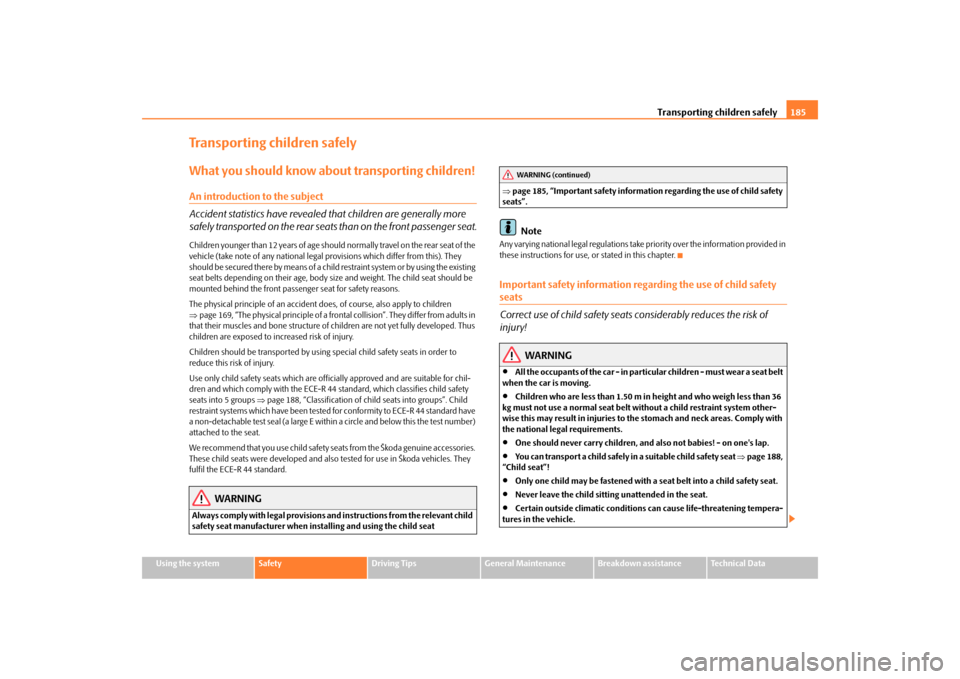
Transporting children safely
185
Using the system
Safety
Driving Tips
General Maintenance
Breakdown assistance
Technical Data
Transporting children safelyWhat you should know about transporting children!An introduction to the subject Accident statistics have revealed that children are generally more safely transported on the rear seat
s than on the fron
t passenger seat.
Children younger than 12 years of age should
normally travel on the rear seat of the
vehicle (take note of any na
tional legal provisions which differ from this). They
should be secured there by means of a child restraint system or by using the existing seat belts depending on their age, body si
ze and weight. The child seat should be
mounted behind the front passen
ger seat for safety reasons.
The physical principle of an accident do
es, of course, also apply to children
⇒ page 169, “The physical principle of a fronta
l collision”. They differ from adults in
that their muscles and bone structure of ch
ildren are not yet fully developed. Thus
children are exposed to increased risk of injury. Children should be transported by using special child safety seats in order to reduce this risk of injury. Use only child safety seats which are offici
ally approved and are suitable for chil-
dren and which comply with the ECE-R 44
standard, which classifies child safety
seats into 5 groups
⇒page 188, “Classification of child seats into groups”. Child
restraint systems which have been tested for conformity to ECE-R 44 standard have a non-detachable test seal (a large E within
a circle and below this the test number)
attached to the seat. We recommend that you use ch
ild safety seats from the Škoda genuine accessories.
These child seats were developed and also
tested for use in Škoda vehicles. They
fulfil the ECE-R 44 standard.
WARNING
Always comply with legal provisions and instructions from the relevant child safety seat manufacturer when in
stalling and using the child seat
⇒ page 185, “Important safety information regarding the use of child safety seats”.
Note
Any varying national legal regulations take priority over the information provided in these instructions for use, or stated in this chapter.Important safety information regarding the use of child safety seats Correct use of child safety seats
considerably reduces the risk of
injury!
WARNING
•
All the occupants of the car - in particular children - must wear a seat belt
when the car is moving.•
Children who are less than 1.50 m in height and who weigh less than 36
kg must not use a normal seat belt without a child restraint system other- wise this may result in injuries to the stomach and neck areas. Comply with the national legal requirements.•
One should never carry children, and also not babies! - on one's lap.
•
You can transport a child safely in
a suitable child safety seat
⇒page 188,
“Child seat”!•
Only one child may be fastened with a seat belt into a child safety seat.
•
Never leave the child sitting unattended in the seat.
•
Certain outside climatic conditions can cause life-threatening tempera-
tures in the vehicle.
WARNING (continued)
s2dk.1.book Page 185 Wednesday, April 8, 2009 12:23 PM
Page 187 of 294
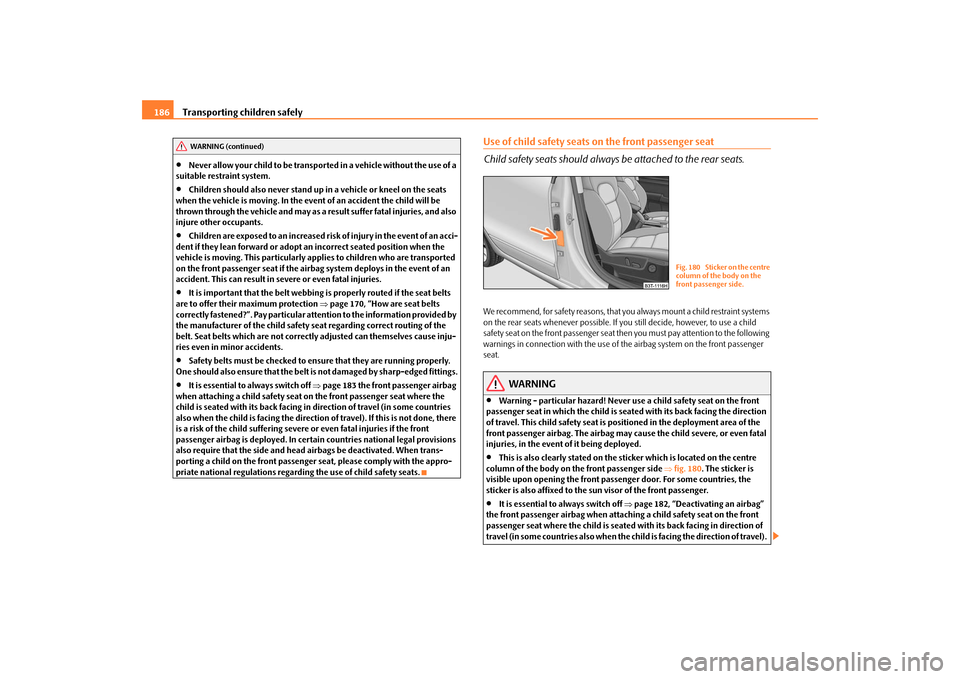
Transporting children safely
186
•
Never allow your child to be transported in a vehicle without the use of a
suitable restraint system.•
Children should also never stand up in a vehicle or kneel on the seats
when the vehicle is moving. In the even
t of an accident the child will be
thrown through the vehicle and may as a
result suffer fatal
injuries, and also
injure other occupants.•
Children are exposed to an increased risk
of injury in the event of an acci-
dent if they lean forward or adopt an incorrect seated position when the vehicle is moving. This particularly applies to children who are transported on the front passenger seat if the airb
ag system deploys in the event of an
accident. This can result in severe or even fatal injuries.•
It is important that the belt webbing is properly routed if the seat belts
are to offer their maximum protection
⇒page 170, “How are seat belts
correctly fastened?”. Pay particular atte
ntion to the information provided by
the manufacturer of the child safety se
at regarding correc
t routing of the
belt. Seat belts which are
not correctly adjusted ca
n themselves cause inju-
ries even in minor accidents.•
Safety belts must be checked to ensure that they are running properly.
One should also ensure that the belt
is not damaged by sh
arp-edged fittings.
•
It is essential to always switch off
⇒page 183 the front passenger airbag
when attaching a child safety seat on
the front passenger seat where the
child is seated with its back facing in direction of travel (in some countries also when the child is facing the direction of travel). If this is not done, there is a risk of the child suffering severe
or even fatal injuries if the front
passenger airbag is deploy
ed. In certain countries national legal provisions
also require that the si
de and head airbags be
deactivated. When trans-
porting a child on the front passenger seat, please comply with the appro- priate national regulations regarding the use of child safety seats.
Use of child safety seats on the front passenger seat Child safety seats should always
be attached to the rear seats.
We recommend, for safety reasons, that you always mount a child restraint systems on the rear seats whenever possible. If you still decide, however, to use a child safety seat on the front passenger seat th
en you must pay attention to the following
warnings in connection with the use of th
e airbag system on the front passenger
seat.
WARNING
•
Warning - particular hazard! Never use a child safety seat on the front
passenger seat in which the child is seat
ed with its back facing the direction
of travel. This child safety seat is positioned in the deployment area of the front passenger airbag. The airbag may
cause the child severe, or even fatal
injuries, in the event of it being deployed.•
This is also clearly stated on the sticker which is located on the centre
column of the body on the front passenger side
⇒fig. 180
. The sticker is
visible upon opening the front passen
ger door. For some countries, the
sticker is also affixed to the sun visor of the front passenger.•
It is essential to always switch off
⇒page 182, “Deactivating an airbag”
the front passenger airbag when attach
ing a child safety seat on the front
passenger seat where the child is seated
with its back facing in direction of
travel (in some countries al
so when the child is facing the direction of travel).
WARNING (continued)
Fig. 180 Sticker on the centre column of the body on the front passenger side.
s2dk.1.book Page 186 Wednesday, April 8, 2009 12:23 PM
Page 188 of 294
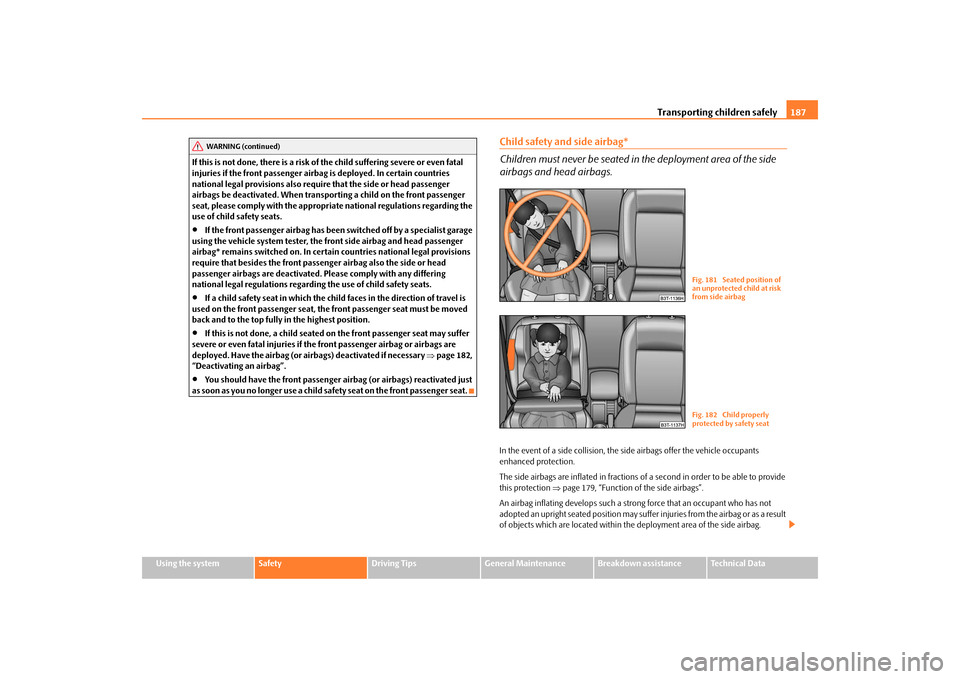
Transporting children safely
187
Using the system
Safety
Driving Tips
General Maintenance
Breakdown assistance
Technical Data
If this is not done, there is a risk of
the child suffering severe or even fatal
injuries if the front passenger airbag
is deployed. In certain countries
national legal provisions also requir
e that the side or head passenger
airbags be deactivated. When transporting a child on the front passenger seat, please comply with the appropri
ate national regulations regarding the
use of child safety seats.•
If the front passenger airbag has been
switched off by a specialist garage
using the vehicle system tester, the fr
ont side airbag and head passenger
airbag* remains switched on. In certai
n countries national legal provisions
require that besides the front passenger airbag also the side or head passenger airbags are deactivated.
Please comply with any differing
national legal regulations regardin
g the use of child safety seats.
•
If a child safety seat in which the child faces in the direction of travel is
used on the front passenger seat, the
front passenger seat must be moved
back and to the top fully in the highest position.•
If this is not done, a child seated on the front passenger seat may suffer
severe or even fatal injuries if the
front passenger airbag or airbags are
deployed. Have the airbag (or ai
rbags) deactivated if necessary
⇒page 182,
“Deactivating an airbag”.•
You should have the front passenger airbag (or airbags) reactivated just
as soon as you no longer use a child sa
fety seat on the front passenger seat.
Child safety and side airbag* Children must never be seated in
the deployment area of the side
airbags and head airbags.In the event of a side collision, the si
de airbags offer the vehicle occupants
enhanced protection. The side airbags are inflated in fractions of
a second in order to be able to provide
this protection
⇒page 179, “Function of
the side airbags”.
An airbag inflating develops such a strong force that an occupant who has not adopted an upright seated position may suffer
injuries from the airbag or as a result
of objects which are located within th
e deployment area of the side airbag.
WARNING (continued)
Fig. 181 Seated position of an unprotected child at risk from side airbagFig. 182 Child properly protected by safety seat
s2dk.1.book Page 187 Wednesday, April 8, 2009 12:23 PM
Page 189 of 294
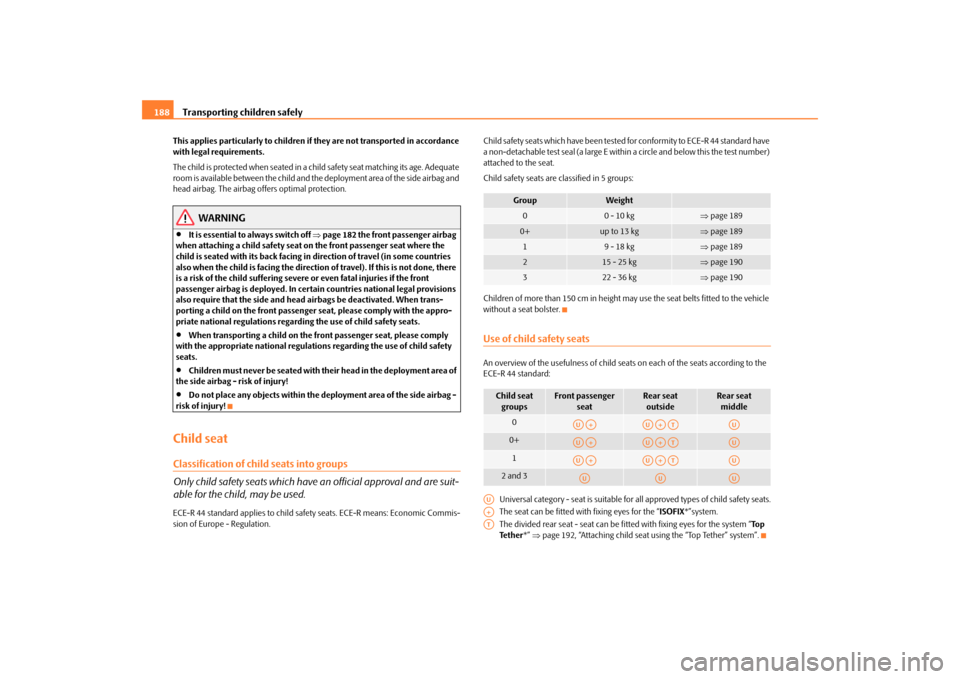
Transporting children safely
188
This applies particularly to children if they are not transported in accordance with legal requirements. The child is protected when seated in a child safety seat matching its age. Adequate room is available between th
e child and the deployment area of the side airbag and
head airbag. The airbag offers optimal protection.
WARNING
•
It is essential to always switch off
⇒page 182 the front passenger airbag
when attaching a child safety seat on
the front passenger seat where the
child is seated with its back facing in direction of travel (in some countries also when the child is facing the direction of travel). If this is not done, there is a risk of the child suffering severe
or even fatal injuries if the front
passenger airbag is deploy
ed. In certain countries national legal provisions
also require that the si
de and head airbags be
deactivated. When trans-
porting a child on the front passenger seat, please comply with the appro- priate national regulations regarding the use of child safety seats.•
When transporting a child on the fr
ont passenger seat, please comply
with the appropriate national regulations regarding the use of child safety seats.•
Children must never be seated with their head in the deployment area of
the side airbag - risk of injury!•
Do not place any objects within the deployment area of the side airbag -
risk of injury!Child seatClassification of child seats into groups Only child safety seats which have an official approval and are suit- able for the child, may be used.ECE-R 44 standard applies to child safety seats. ECE-R means: Economic Commis- sion of Europe - Regulation.
Child safety seats which have been tested for conformity to ECE-R 44 standard have a non-detachable test seal (a large E within a circle and below this the test number) attached to the seat. Child safety seats are classified in 5 groups: Children of more than 150 cm in height may use the seat belts fitted to the vehicle without a seat bolster.Use of child safety seatsAn overview of the usefulness of child se
ats on each of the seats according to the
ECE-R 44 standard:
Universal category - seat is suitable for all approved types of child safety seats. The seat can be fitted with
fixing eyes for the “
ISOFIX
*”system.
The divided rear seat - seat can be fitt
ed with fixing eyes for the system “
To p
Te t h e r
*” ⇒page 192, “Attaching child seat using the “Top Tether” system”.
Group
Weight
0
0 - 10 kg
⇒page 189
0+
up to 13 kg
⇒page 189
1
9 - 18 kg
⇒page 189
2
15 - 25 kg
⇒page 190
3
22 - 36 kg
⇒page 190
Child seat groups
Front passenger
seat
Rear seat outside
Rear seat middle
0
0+
1
2 and 3
AUA+
AUA+AT
AU
AUA+
AUA+AT
AU
AUA+
AUA+AT
AU
AU
AU
AU
AUA+AT
s2dk.1.book Page 188 Wednesday, April 8, 2009 12:23 PM